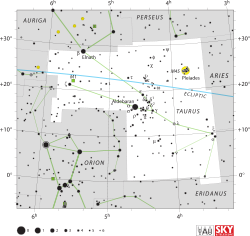Delta2 Tauri
| Observation data Epoch J2000.0 Equinox J2000.0 (ICRS) | |
|---|---|
| Constellation | Taurus |
| Right ascension | 04h 24m 05.75985s[1] |
| Declination | +17° 26′ 38.8583″[1] |
| Apparent magnitude (V) | +4.80[2] |
| Characteristics | |
| Spectral type | A2 Vs[3] |
| U−B color index | +0.12[2] |
| B−V color index | +0.15[2] |
| Astrometry | |
| Radial velocity (Rv) | +37.1[4] km/s |
| Proper motion (μ) | RA: +108.16[1] mas/yr Dec.: −34.66[1] mas/yr |
| Parallax (π) | 20.21 ± 0.40 mas[1] |
| Distance | 161 ± 3 ly (49.5 ± 1.0 pc) |
| Absolute magnitude (MV) | +1.62[5] |
| Details | |
| Mass | 1.79[6] M☉ |
| Radius | 1.8[7] R☉ |
| Luminosity | 27[8] L☉ |
| Surface gravity (log g) | 4.15[4] cgs |
| Temperature | 7,997[4] K |
| Metallicity [Fe/H] | +0.14[4] dex |
| Rotational velocity (v sin i) | 42[4] km/s |
| Age | 449[6] Myr |
| Other designations | |
| Database references | |
| SIMBAD | data |
Delta2 Tauri (δ2 Tauri) is a solitary,[10] white-hued star in the zodiac constellation of Taurus. Based upon an annual parallax shift of 20.21 mas as seen from Earth,[1] it is located roughly 161 light years distant from the Sun. It is separated from δ1 Tauri by 0.3° on the sky[11] and is faintly visible to the naked eye with an apparent visual magnitude of +4.80.[2] The star is considered a member of the Hyades cluster.[12]
At the estimated age of 449 million years,[6] this is an A-type main-sequence star with a stellar classification of A2 Vs,[3] where the 's' suffix indicates narrow (sharp) absorption lines. It has 1.8[6] times the mass of the Sun and about 1.8[7] times the Sun's radius. The star is radiating 27[8] times the Sun's luminosity from its photosphere at an effective temperature of 7,997 K.[4]
δ2 Tauri is a source of X-ray emission with a luminosity of 101.1×1020 W. Since A-type stars are not normally a source of X-rays, this emission may be coming from an unknown companion or from a line of sight source.[13]
References[edit]
- ^ a b c d e f van Leeuwen, F. (2007), "Validation of the new Hipparcos reduction", Astronomy and Astrophysics, 474 (2): 653–664, arXiv:0708.1752, Bibcode:2007A&A...474..653V, doi:10.1051/0004-6361:20078357, S2CID 18759600.
- ^ a b c d Johnson, H. L.; et al. (1966), "UBVRIJKL photometry of the bright stars", Communications of the Lunar and Planetary Laboratory, 4 (99): 99, Bibcode:1966CoLPL...4...99J.
- ^ a b Paunzen, E.; et al. (July 2001), "A spectroscopic survey for λ Bootis stars. II. The observational data", Astronomy and Astrophysics, 373 (2): 625–632, Bibcode:2001A&A...373..625P, doi:10.1051/0004-6361:20010630.
- ^ a b c d e f Gebran, M.; et al. (May 2016), "A new method for the inversion of atmospheric parameters of A/Am stars", Astronomy & Astrophysics, 589: 10, arXiv:1603.01146, Bibcode:2016A&A...589A..83G, doi:10.1051/0004-6361/201528052, S2CID 118549566, A83.
- ^ Eggen, Olin J. (July 1998), "The Age Range of Hyades Stars", The Astronomical Journal, 116 (1): 284–292, Bibcode:1998AJ....116..284E, doi:10.1086/300413.
- ^ a b c d David, Trevor J.; Hillenbrand, Lynne A. (2015), "The Ages of Early-Type Stars: Strömgren Photometric Methods Calibrated, Validated, Tested, and Applied to Hosts and Prospective Hosts of Directly Imaged Exoplanets", The Astrophysical Journal, 804 (2): 146, arXiv:1501.03154, Bibcode:2015ApJ...804..146D, doi:10.1088/0004-637X/804/2/146, S2CID 33401607.
- ^ a b Pasinetti Fracassini, L. E.; et al. (February 2001), "Catalogue of Apparent Diameters and Absolute Radii of Stars (CADARS)", Astronomy and Astrophysics, 367 (Third ed.): 521–524, arXiv:astro-ph/0012289, Bibcode:2001A&A...367..521P, doi:10.1051/0004-6361:20000451, S2CID 425754.
- ^ a b Zorec, J.; Royer, F. (2012), "Rotational velocities of A-type stars. IV. Evolution of rotational velocities", Astronomy & Astrophysics, 537: A120, arXiv:1201.2052, Bibcode:2012A&A...537A.120Z, doi:10.1051/0004-6361/201117691, S2CID 55586789.
- ^ "del02 Tau". SIMBAD. Centre de données astronomiques de Strasbourg. Retrieved 2017-08-07.
- ^ Eggleton, P. P.; Tokovinin, A. A. (September 2008), "A catalogue of multiplicity among bright stellar systems", Monthly Notices of the Royal Astronomical Society, 389 (2): 869–879, arXiv:0806.2878, Bibcode:2008MNRAS.389..869E, doi:10.1111/j.1365-2966.2008.13596.x, S2CID 14878976.
- ^ O'Meara, Stephen James (2016), Deep-Sky Companions: The Caldwell Objects, Cambridge University Press, p. 195, ISBN 978-1107083974.
- ^ Gebran, M.; Vick, M.; Monier, R.; Fossati, L. (November 2010), "Chemical composition of A and F dwarfs members of the Hyades open cluster", Astronomy and Astrophysics, 523: 13, arXiv:1006.5284, Bibcode:2010A&A...523A..71G, doi:10.1051/0004-6361/200913273, S2CID 7164596, A71.
- ^ Schröder, C.; Schmitt, J. H. M. M. (November 2007), "X-ray emission from A-type stars", Astronomy and Astrophysics, 475 (2): 677–684, Bibcode:2007A&A...475..677S, doi:10.1051/0004-6361:20077429.

